Are you living in Brooklyn, NYC, Manhattan, NYC, or Queens, NYC and suffering from toenail fungus? There are several types of toenail fungus, but all of them are a pain to deal with. You may be researching all the local podiatrists and looking for answers to all your questions. Toenail fungus can significantly affect your quality of life, and it’s never a problem that you simply have to live with. You have many options available for treating toenail fungus that can help you get your life back to normal. At Best Foot Doctor NY, we can perform state-of-the-art procedures like pinpoint laser treatments to resolve your toenail fungus as quickly as possible.
This article will answer your questions about toenail fungus, from common causes to identification and treatment. Read on to discover more about your options for toenail fungus treatment.
What Is Toenail Fungus? NYC’s Best Podiatrist Explains
First of all, toenail fungus is an infection. It’s not a bacteria or a virus, so treatments for bacterial or viral infections will be of no use here. Toenail fungus belongs to a separate category of organism: fungi. Its medical name is onychomycosis, and it affects around 14% of all human beings.
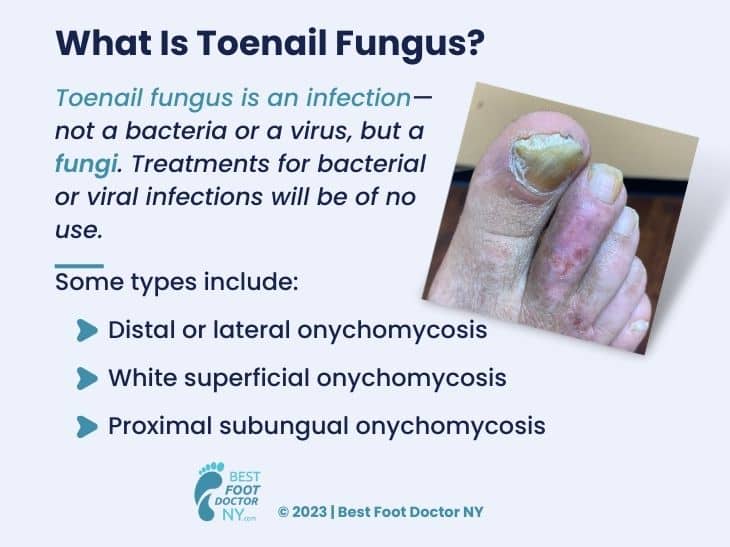
At Best Foot Doctor NY, we see patients with several different types of toenail fungus. Some of these include:
Distal or lateral onychomycosis
Distal or lateral onychomycosis is the most common type of toenail fungus. It affects the nail bed and the underside of your toenail. It causes inflammation and thickening of your nail, which can cause it to begin detaching from your nail bed. This fungus can affect fingernails, too, but it is much more common in toenails.
White superficial onychomycosis
White superficial onychomycosis is a less common type of toenail fungus. It causes white patches on your nail plate, and it can eventually spread to the nail bed. As the fungus grows, these white patches will gradually get closer together, until they take over the surface of your nail. Your nail texture may change and begin to crumble, and eventually, your nails might change from whitish to yellowish in color. This type of fungus is more likely to affect fingernails than other types.
Proximal subungual onychomycosis
Proximal subungual onychomycosis is the least common type of nail fungus discussed here. It begins in your cuticle area, and from there it can spread to the rest of your nail. This often causes visible white bands to develop on your nail, and it can also cause your nail to separate from the nail bed.
In each case, the names of these toenail fungus types refer to the appearance of the fungus and its location on your nail. All these types of toenail fungus have a lot in common: they’re a real nuisance, and they call for effective toenail fungus treatment as soon as possible!
How Does Toenail Fungus Affect Patients?
| What a Podiatrist in NYC Says
Toenail fungus is more than just an infection. It’s a medical condition, but it’s also an aesthetic problem. It can affect the way your nail looks, and it may keep you from wanting others to see your feet. Many people dealing with toenail fungus feel insecure and struggle with low self-esteem. Toenail fungus can be painful, and it can even cause someone to withdraw from social situations. Some people with toenail fungus refuse to go barefoot or wear open-toed shoes, and they may miss out on activities like swimming or going to the beach.
However, it’s important to remember that toenail fungus is a common condition. Our team at Best Foot Doctor NY sees many patients with toenail fungus, and it is nothing to be embarrassed about. Finding the best toenail fungus treatment to beat the problem is possible.
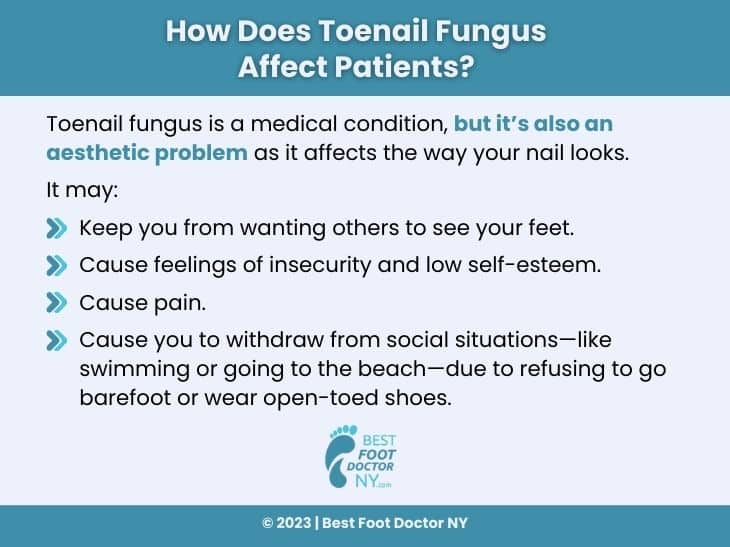
Is Toenail Fungus Contagious?
Toenail fungus can easily spread to other people. It creates a skin fungus that can travel on shower stalls, slippers, towels, swimming pools, and pedicure tools. If you have toenail fungus, you should exercise caution in settings like gyms, swimming pools, public showers, beaches, and other places where your fungus might spread to others.
For people with a medical condition that compromises their immune system, like diabetes, toenail fungus can be even more contagious. Since it can spread so easily, treating toenail fungus early is very important! A comprehensive medical solution like nail avulsion with pinpoint laser treatments can help you beat your infection as quickly as possible.
Do I Have Toenail Fungus?
How do you know whether you have toenail fungus or not? Before seeking toenail fungus treatment, it’s important to get a correct diagnosis. Otherwise, you might waste time and money trying to solve the problem with the wrong tools!
What are the symptoms of toenail fungus?
Common symptoms include:
- Thickened nails
- Yellowish or discolored nails
- Brittle nails
Some patients notice that their nails have yellowed, but not thickened. Even without thickening, discoloration alone can indicate the presence of fungus. Avoid the pitfall of thinking you can’t have fungus, just because your nail is a normal thickness.
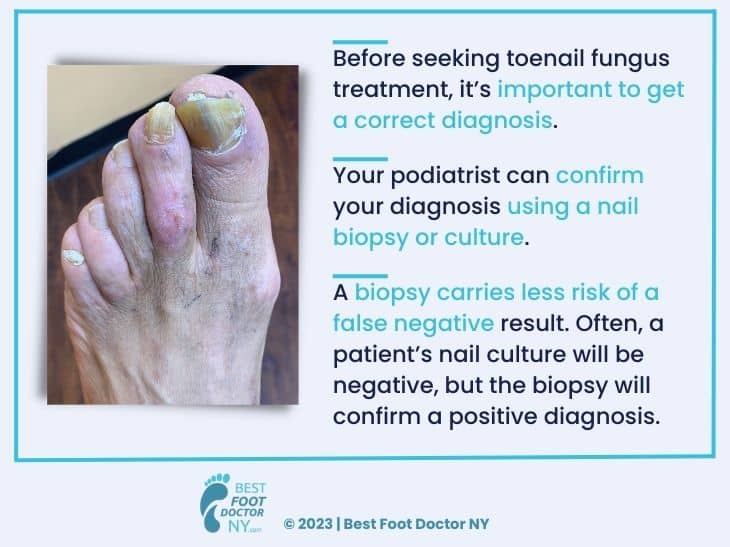
What is the best way to diagnose toenail fungus?
Your podiatrist can confirm your diagnosis using a nail biopsy or culture. A biopsy carries less risk of a false negative result. Often, a patient’s nail culture will be negative, but the biopsy will confirm a positive diagnosis.
How can I tell if I have toenail fungus or another condition?
There are several other conditions commonly mistaken for toenail fungus. These include:
- yeast infection
- psoriasis
- a naturally thick nail plate
- subungual hematoma
To ensure you get the best toenail fungus treatment possible, a nail biopsy is recommended. It can not only rule out other conditions, but can also identify the type of fungus you’re dealing with, which can help to inform your treatment plan.
What is the difference between toenail fungus and athlete’s foot?
There is often a close relationship between athlete’s foot and toenail fungus. In fact, they can be caused by the same fungus and occur together. Athlete’s foot often develops on the skin of active peoples’ feet, due to excessive sweating. The fungus can then spread from your skin to your nails.
In these cases, the toenail fungus is always accompanied by skin fungus, which causes scaly, itchy skin around and between your toes. Thus, treating the skin fungus without treating toenail fungus will not eradicate the problem.
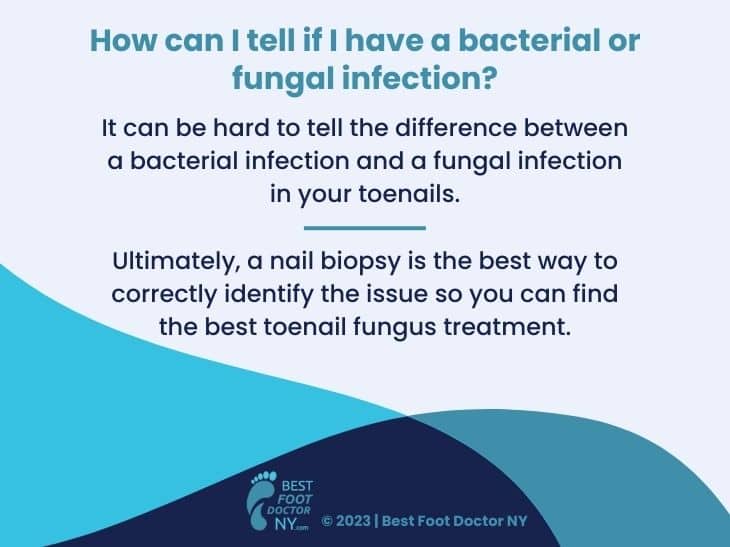
How can I tell if I have a bacterial or fungal infection?
It can be hard to tell the difference between a bacterial infection and a fungal infection in your toenails. Bacterial infections can also cause thickened toenails. They can also cause the skin around your nail to become inflamed and swollen. Ultimately, a nail biopsy is the best way to correctly identify the issue so you can find the best toenail fungus treatment.
Why Do I Have Toenail Fungus?
| NYC’s Best Podiatrist Answers
Patients sometimes feel embarrassed about having toenail fungus, but it’s a common condition that’s nothing to be ashamed of. Having toenail fungus does not necessarily mean that your personal hygiene is insufficient. It can have many different root causes. Some of them are more preventable than others. Taking the recommended precautions can reduce your likelihood of developing toenail fungus. But sometimes toenail fungus strikes, despite your best efforts! At Best Foot Doctor NY, we help patients who are dealing with toenail fungus for a wide variety of reasons.
What causes toenail fungus?
There are several factors that commonly cause toenail fungus:
- Sweat
- Heat
- Tight shoes
- Moisture
- Exposure to a fungus
- Trauma to your nail bed
Trauma to your nail bed could happen when you stub your toe, trip and fall, or drop something heavy on your foot. This can cause the capillaries in your toe to rupture, which leads to a hematoma, or blood clot. This hematoma can end up hosting your toenail fungus and giving it a rich environment in which to grow.
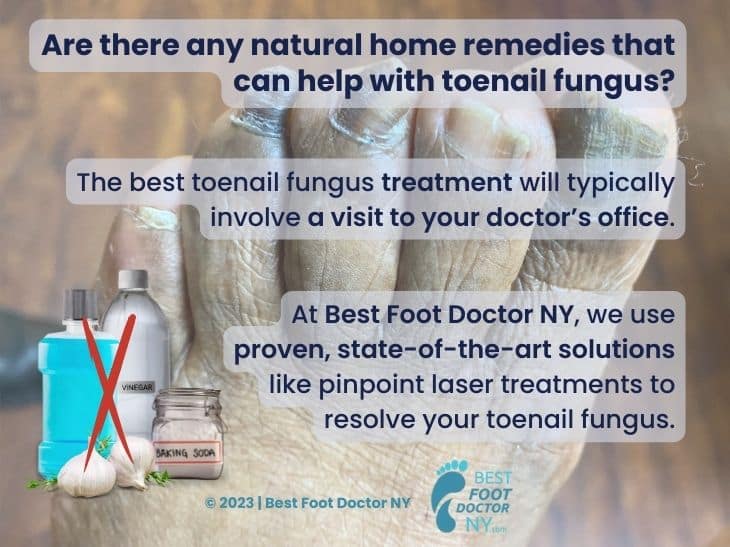
Can I Treat My Toenail Fungus At Home?
If you’re wondering how to get rid of toenail fungus, treating toenail fungus at home seems like a good place to start. If you lead a busy lifestyle, it’s tempting to try to solve the problem on your own, without making a doctor’s appointment. However, treating your toenail fungus at home is rarely successful. A proven medical procedure, like nail avulsion with laser treatment, is far more likely to be successful. Let’s take a look at a few of the most common approaches to home toenail fungus treatment.
Are there any natural home remedies that can help with toenail fungus?
There are many traditional remedies people recommend for toenail fungus treatment. Some of these include:
- Baking soda
- Vinegar
- Mouthwash
- Garlic
While some home remedies may have mild antifungal properties, results will vary widely. If you’re wondering how to get rid of toenail fungus for good, these treatments may not be the answer you’re looking for. Most of them have nothing but anecdotal effectiveness to support their effectiveness.
So, are there any natural remedies that can help with toenail fungus? Unfortunately, it’s hard to find home remedies that produce a reliable, permanent solution. The best toenail fungus treatment will typically involve a visit to your doctor’s office. Ineffective treatments will only delay your relief from toenail fungus and give the infection more time to spread. At Best Foot Doctor NY, we use proven, state-of-the-art solutions like pinpoint laser treatments to resolve your toenail fungus.

Are there any dietary changes I can make to help with toenail fungus?
Will changing your diet be an effective toenail fungus treatment? Probably not. However, although it’s unlikely to cure your condition, making some dietary changes might have a limited effect.
Foods to avoid when you have toenail fungus
You may be able to discourage the fungus from growing as rapidly by avoiding:
- Sugar
- Carbohydrates
- Alcohol
Fungi tend to feed on simple carbohydrates, so by decreasing your carb intake, you may be able to create a less ideal environment. Alcohol can suppress your immune system when too much is consumed. Of course, cutting down on sugar, simple carbs and alcohol can have a variety of health benefits unrelated to toenail fungus treatment. Making these changes may help to lower your blood pressure, reduce excess weight, improve your mood, and more.
Foods to add to your diet for nail health
What about foods to add to your diet for toenail fungus treatment? In general, foods that boost your immune system will probably have a positive impact in your battle with toenail fungus. Some of these include:
- Citrus fruits, which are high in vitamin C
- Garlic, which contains immune-boosting compounds like allicin
- Spinach, which is rich in many antioxidants that can strengthen your immune system
- Protein-rich foods, which can provide adequate materials to help your body build nails
However, if you’re dealing with any of the various types of toenail fungus, diet alone probably won’t solve the problem. Dietary changes may enhance other treatments, but they should not replace them. If you don’t currently have toenail fungus, eating a healthy diet can help lower your risk! Of course, it also carries many other health benefits.
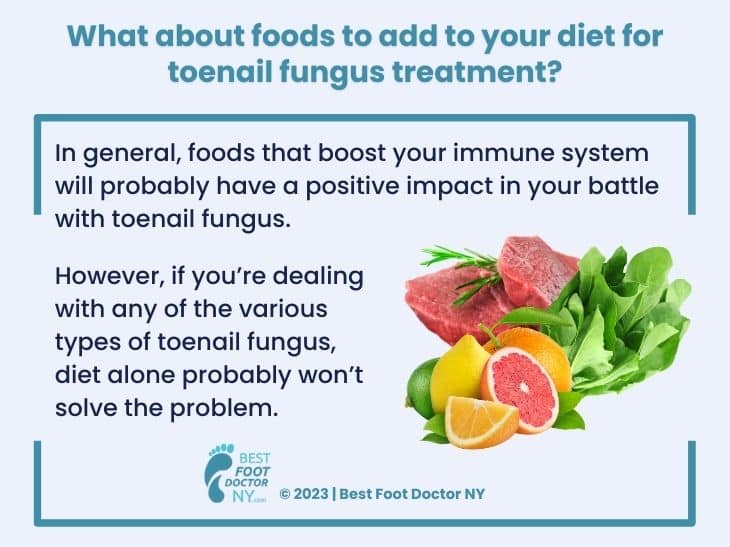
Vitamins to add to your diet for nail health
Adding some vitamin or mineral supplements to your diet can promote overall nail health. These may include:
- Biotin to make nails stronger
- Magnesium to prevent ridges from forming on your nails
- Vitamin C to support collagen production
However, no supplement is likely to make your toenail fungus go away on its own. Ask your doctor for advice when adding supplements to your diet.
Are there any over-the-counter medications that can help with toenail fungus?
A NYC Podiatrist’s Guide
In general, over-the-counter medications are not the best toenail fungus treatment you can choose. They will rarely be as effective as prescription medications, and they might not be covered by insurance. However, many patients try these as an initial treatment.
Treating toenail fungus with terbinafine
The most popular OTC treatment for toenail fungus is terbinafine. While the oral form of terbinafine requires a prescription, you can buy topical solutions on your drugstore shelf. These will often be in the form of creams or ointments.
Terbinafine can interact with many other drugs you may be taking. It’s important to discuss your toenail fungus treatment with your doctor, so they can offer any needed guidance. A podiatrist at Best Foot Doctor NY will be a valuable source of advice when it comes to how to get rid of toenail fungus.
Treating toenail fungus with clotrimazole
You can buy clotrimazole on a drugstore shelf, labeled as a toenail fungus treatment. However, it’s often unsuccessful. It may be effective for certain types of fungus on the skin, but it’s usually not the best toenail fungus treatment.
Treating toenail fungus with mentholated medications
Some patients try treating toenail fungus with plant oils or medications that contain them. Menthol, for example, is an organic substance derived from plants in the mint family. You can buy menthol-containing products at your local drugstore. They’re often advertised as treatments for chest congestion or nasal congestion. Unfortunately, this is not a reliable toenail fungus treatment.
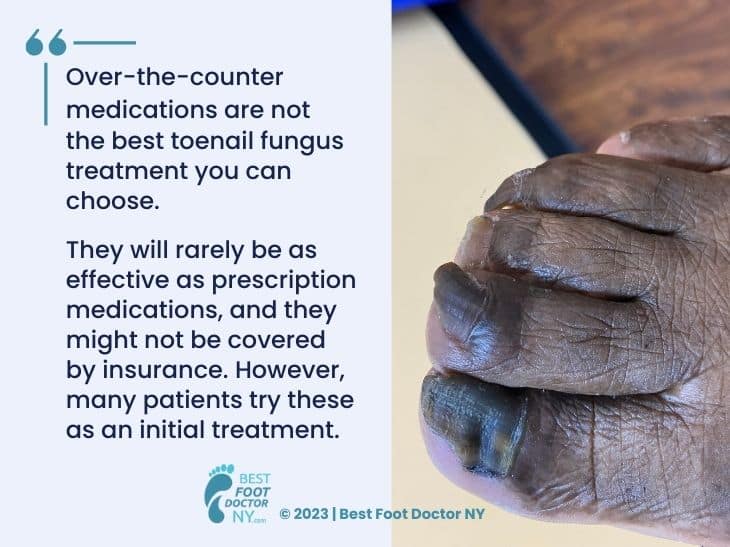
Treating toenail fungus with antifungal nail polish
You can buy various types of toenail fungus treatments in the form of nail polish. Some of these are colored polishes, while others are clear. In some cases, the polish needs to be removed and reapplied every day.
Patients are often drawn to these antifungal nail polishes because they may offer a way to cover up your unsightly toenail fungus. However, antifungal polish may not be the best toenail fungus treatment for you. Nail polish can prevent your nail from getting enough airflow, which can encourage fungus to stick around. The success rate of these products tends to be relatively low.
Treating toenail fungus with essential oils
If you look online for toenail fungus treatment advice, you may find people suggesting that various essential oils can help. Tea tree oil is among the most common, but you may also hear that peppermint, clove, or other oils can be used for treating toenail fungus. Does this sound too good to be true? It usually is. Essential oils are not a trustworthy toenail fungus treatment. Furthermore, handling them improperly and using them topically in concentrations that are too high can be dangerous.
Should I Seek Medical Treatment in Brooklyn, NYC, Queens, NYC, or Manhattan, NYC for Toenail Fungus?
If home remedies and over-the-counter solutions can’t be trusted, you might be wondering how to get rid of toenail fungus. The best treatment for all types of toenail fungus is usually available at your podiatrist’s office. If you suspect that you’re dealing with toenail fungus, it’s best to start treating toenail fungus as early as possible. If you allow it to keep growing, it can affect more of your nail structure and the surrounding skin, and it can become even harder to get rid of.
What treatments are available for toenail fungus?
There are several types of effective toenail fungus treatments, and they each have different success rates, as well as unique pros and cons. These toenail fungus treatments can be divided into the following categories.
Topical creams and gels for treating toenail fungus
The success rate of topical creams and gels is around 7% to 20%. These are typically only effective when your toenail fungus is in its early stages. You may need to use topical treatments for a year or more before seeing results.
Oral tablets for treating toenail fungus
Common oral tablets for treating toenail fungus include itraconazole, terbinafine, and griseofulvin. These have a higher success rate than topical treatments–around 65%. It’s important to note that oral tablets may have side effects. They can elevate your liver enzymes and lead to unwanted gastrointestinal symptoms. However, when oral tablets work for treating toenail fungus, the results are typically faster. You may see results in as little as five months.
Terbinafine for treating toenail fungus orally
Terbinafine is one of the most popular oral tablets for treating toenail fungus. It works by creating holes in the cell membranes of your toenail fungus. The purpose of the cell membrane is to keep the inside of each cell intact. When this membrane is broken, the cell contents can no longer function together as a unit, and the fungus is killed. Terbinafine will also help prevent new fungus from forming.

Itraconazole for treating toenail fungus orally
Itraconazole works by inhibiting an important enzyme that your toenail fungus needs to survive. It’s typically associated with side effects that are relatively minor. It also helps to prevent new fungus from forming.
Griseofulvin for treating toenail fungus orally
Griseofulvin is often helpful in treating skin infections as well as toenail fungus. This medication can be helpful if you are suffering from athlete’s foot. How does griseofulvin work to treat toenail fungus? In order to survive, the cells of your toenail fungus need to be able to split and reproduce. This medication prevents the fungal cells from dividing, so the fungus will eventually be eradicated.
Laser treatments for treating toenail fungus
Your doctor can use a pinpoint laser treatment to address your toenail fungus. This procedure is FDA approved and carries no side effects . It’s been proven to successfully cure toenail fungus around 70% to 80% of the time. You may see results in around five to eight months.
How can laser treatment effectively treat toenail fungus? Carefully targeted pinpoint treatment can cause heat to develop in the affected areas of your nail. This can prevent your fungus from reproducing and growing by damaging its cells. Laser treatment will not cause harm to nails and skin that are unaffected by the fungus.
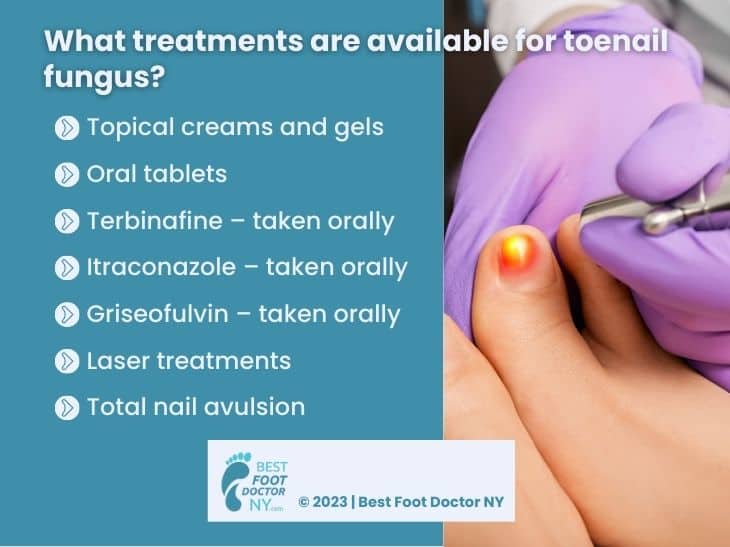
Total nail avulsion for treating toenail fungus
Total nail avulsion, combined with subsequent laser treatment, has the highest rate of success as a toenail fungus treatment. Removing the nail helps to eliminate some of the fungus. It also makes it easier for laser treatments and topical gels to reach the affected areas and destroy the fungus.
Toenail fungus originates from the nail matrix and the nail bed. When your nail is removed, the nail plate will no longer resist the laser and medications your doctor is using to kill the fungus. After a nail avulsion, you can expect a new, healthy nail to grow within six to eight weeks. This treatment option has a success rate around 80% to 90%. Nail avulsion with laser treatment is the fastest and most effective way to eliminate toenail fungus. For many patients, this may be the best toenail fungus treatment available.
How long does it take to treat toenail fungus?
The length of time it takes to treat your toenail fungus will depend on the treatment option you choose. It takes time to kill the fungus and grow a new, healthy nail. Some treatments may take a year or more to be effective. Others can be successful in around six to eight weeks. Whatever treatment option you choose, it’s important to consistently follow your doctor’s advice, even if you don’t see results right away.
Are there any side effects associated with toenail fungus treatments?
Some oral toenail fungus treatments, such as terbinafine, can raise your liver enzymes or cause gastrointestinal problems. Your doctor can monitor your liver enzymes to ensure they stay within a healthy range. To effectively monitor side effects, it’s important to tell your doctor about any toenail fungus treatment you’re using. Are there any risks associated with toenail fungus treatments? There could be, but careful consultation with your doctor can help you manage these risks.
When is it appropriate to see a podiatrist in Brooklyn, Queens, or Manhattan for toenail fungus?
If you think you may have toenail fungus, it’s highly recommended that you visit a podiatrist right away. Toenail fungus is a progressive infection. Over time, it will affect more of your healthy skin. Eventually, it will spread to the rest of your nails. Your podiatrist can help you pick the best toenail fungus treatment for your situation.
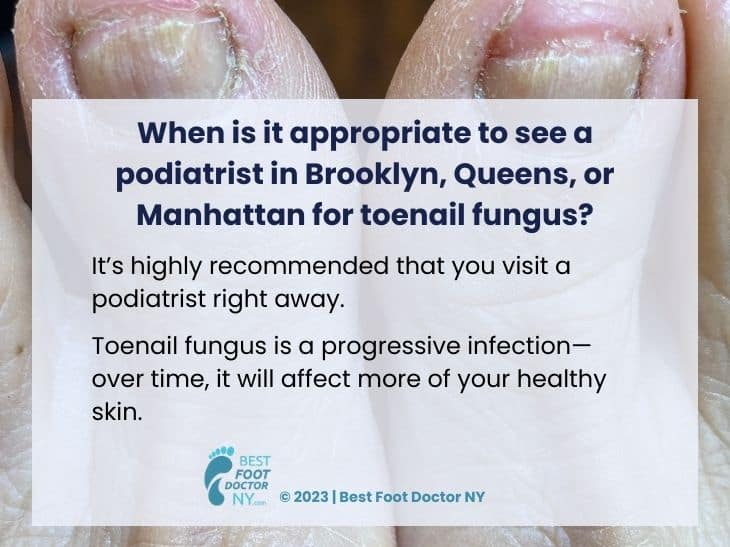
What Should I Do After Successful Toenail Fungus Treatment? NYC Podiatrist Recommendations
Once you’ve successfully treated your toenail fungus, it’s time to breathe a huge sigh of relief. However, the battle isn’t over yet. The best toenail fungus treatment is preventing the fungus from growing in the first place! You’ll need to take careful measures to reduce the risks that your toenail fungus will return.
How can I prevent toenail fungus?
To keep your nails healthy and avoid toenail fungus in the first place, start by following these tips:
- Do not share slippers or shoes with other people
- Only use your own sandals to walk in and around a swimming pool
- Dry your feet thoroughly when you come out of the shower or a swimming pool
- Change your socks at least once a day
Are there any lifestyle changes I can make to reduce the risk of toenail fungus?
Once you’ve successfully treated your toenail fungus, your personal foot hygiene will be very important. If you’ve successfully beaten toenail fungus, the above advice still applies: never share shoes or slippers, change your socks frequently, and avoid contact with moisture as much as possible. After treatment, you might be wondering: how can I reduce the risk of toenail fungus recurring? If you received pinpoint laser treatments, it’s best to repeat them every three to four months for the next year.
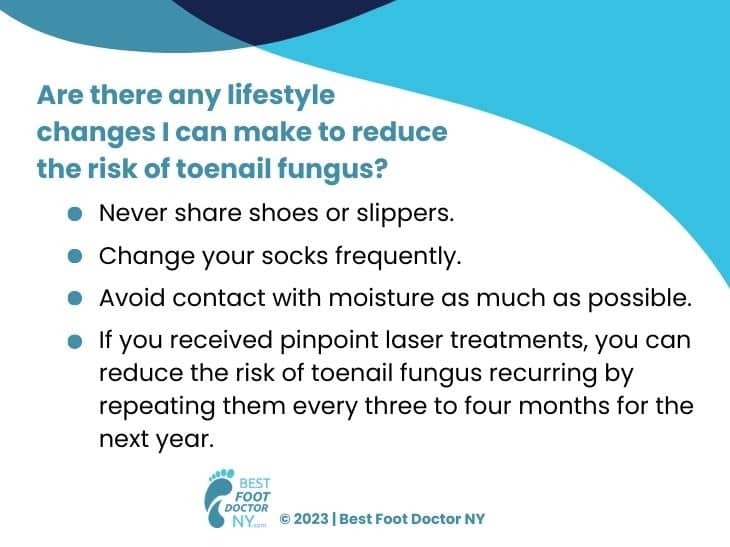
How can I keep my toenails healthy?
For general toenail health, there are several steps you can take. These will not only reduce your risk of toenail fungus, but they’ll also keep your feet in better overall condition.
Avoid overuse of nail polish
Nail polish might look nice, but it doesn’t allow your nail to breathe properly. Also, if you visit a nail salon for pedicures and or nail art services, you may be exposed to bacteria or fungi from other customers. If you paint your nails at home, it’s best to alternate wearing toenail polish with letting your nails go bare for a while.
Wear breathable socks and shoes
If your socks and shoes don’t allow enough ventilation to get to your feet, you’re creating a warm, moist environment. Bacteria and fungi will be more likely to make their home there. Especially if you take part in running or other sports, it’s important to choose footwear that allows airflow to reach your skin. It’s also important to remove your shoes at regular intervals to let them air out.
Pay special attention to your feet when you bathe
Many people get in a hurry when they shower or bathe, and they don’t clean their feet thoroughly enough. Just letting the water run over your feet while you clean the rest of your body is not enough. Thoroughly scrub the tops and bottoms of your feet, and between your toes, every time you wash the rest of your body.
Trim your toenails regularly
When your toenails become overgrown, it’s easier for dirt and debris to stick around. Be careful not to cut your nails too short, and be sure to cut them straight across. You may also want to use a nail file to smooth your nails’ edges. This can prevent small tears or trauma which can lead to infections.
Perform frequent self-exams
If you rarely look at your feet, you may not notice if a problem begins to develop. In most cases, the earlier you know about a foot problem, the faster and more effective your treatment plan may be. Take time to regularly look at your feet. Make sure your toenails look normal, you don’t have any blisters, and your skin is well-hydrated. It’s a good idea to moisturize your feet regularly, too, and this can be a perfect opportunity to do a visual inspection. However, be sure to ask your podiatrist for advice when selecting a foot lotion or cream. Not all brands are created equal, and some may do more harm than good!
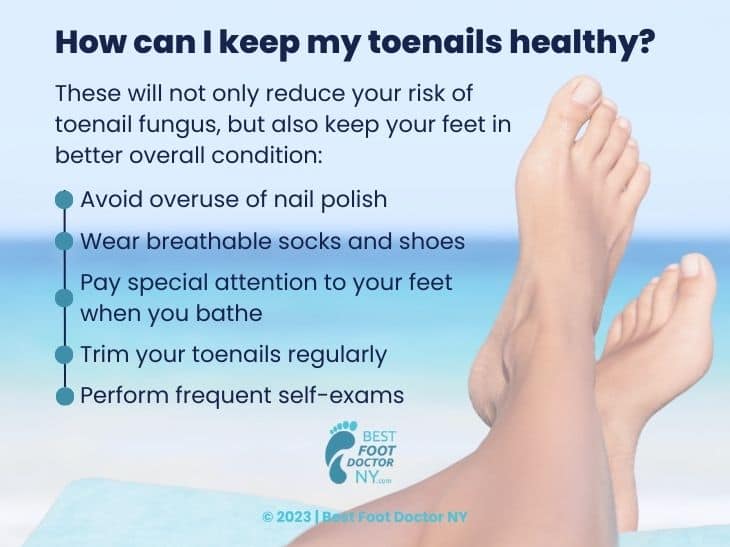
Contact Best Foot Dr NY Today To Get The Help You Need For Toenail Fungus! | NYC
You don’t have to be stuck with toenail fungus forever. There are effective medical treatments available. Are you looking for toenail fungus treatment in Brooklyn, NYC, Manhattan, NYC, or Queens, NYC? Wondering how to get rid of toenail fungus as quickly as possible? Call Dr. Emmanuel Fuzaylov of Best Foot Doctor NY at (718) 291- 9020. You can also book appointments online at one of our six convenient locations.
Treating toenail fungus doesn’t have to be a bad experience. Best Foot Dr NY offers a fast, effective and affordable treatment plan to get rid of your nail fungus. We often perform nail fungus removal with subsequent laser treatment, and we may use topical gels for treating toenail fungus. Our team will review your case and help you select the best treatment plan for your unique situation. Don’t wait any longer–set up an appointment today!
